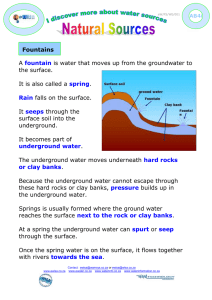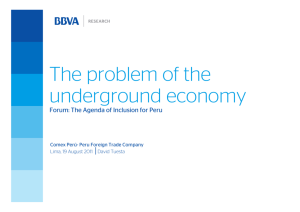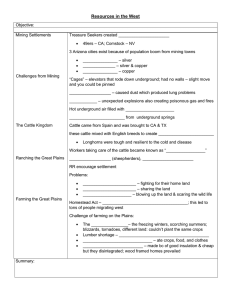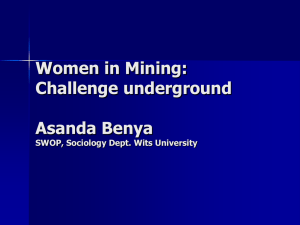315 Pavel Hronček Technical University of Košice Faculty of Mining
advertisement
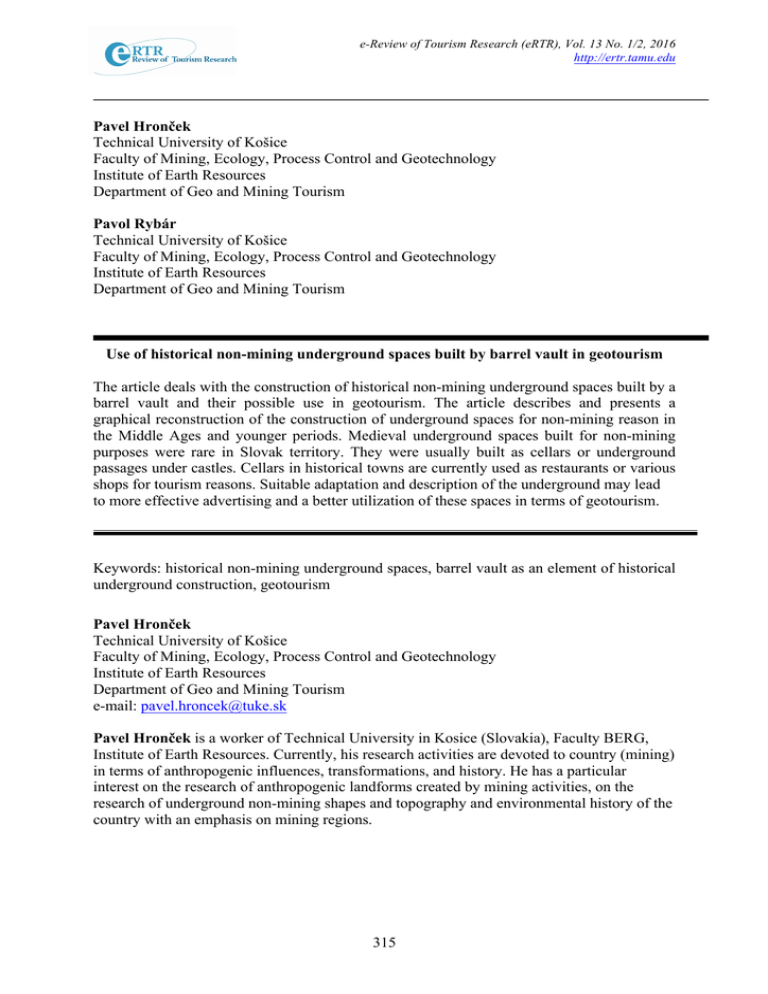
e-Review of Tourism Research (eRTR), Vol. 13 No. 1/2, 2016 http://ertr.tamu.edu Pavel Hronček Technical University of Košice Faculty of Mining, Ecology, Process Control and Geotechnology Institute of Earth Resources Department of Geo and Mining Tourism Pavol Rybár Technical University of Košice Faculty of Mining, Ecology, Process Control and Geotechnology Institute of Earth Resources Department of Geo and Mining Tourism Use of historical non-mining underground spaces built by barrel vault in geotourism The article deals with the construction of historical non-mining underground spaces built by a barrel vault and their possible use in geotourism. The article describes and presents a graphical reconstruction of the construction of underground spaces for non-mining reason in the Middle Ages and younger periods. Medieval underground spaces built for non-mining purposes were rare in Slovak territory. They were usually built as cellars or underground passages under castles. Cellars in historical towns are currently used as restaurants or various shops for tourism reasons. Suitable adaptation and description of the underground may lead to more effective advertising and a better utilization of these spaces in terms of geotourism. Keywords: historical non-mining underground spaces, barrel vault as an element of historical underground construction, geotourism Pavel Hronček Technical University of Košice Faculty of Mining, Ecology, Process Control and Geotechnology Institute of Earth Resources Department of Geo and Mining Tourism e-mail: pavel.hroncek@tuke.sk Pavel Hronček is a worker of Technical University in Kosice (Slovakia), Faculty BERG, Institute of Earth Resources. Currently, his research activities are devoted to country (mining) in terms of anthropogenic influences, transformations, and history. He has a particular interest on the research of anthropogenic landforms created by mining activities, on the research of underground non-mining shapes and topography and environmental history of the country with an emphasis on mining regions. 315 e-Review of Tourism Research (eRTR), Vol. 13 No. 1/2, 2016 http://ertr.tamu.edu Pavol Rybár Technical University of Košice Faculty of Mining, Ecology, Process Control and Geotechnology Institute of Earth Resources Department of Geo and Mining Tourism e-mail: pavol.rybar@tuke.sk Pavol Rybár is a full professor at Technical University Kosice, Slovakia. He has a forty working experience in geology, mining technology, utilization of renewable sources of energy and geotourism. He has a particular interest on the evaluation of geo and mining sites, theoretical works connected with the definition of geo and mining tourism, as well as mining heritage, and on the implementation of IT technology in the presentation of objects of geo and mining tourism and heritage. 316 e-Review of Tourism Research (eRTR), Vol. 13 No. 1/2, 2016 http://ertr.tamu.edu Introduction People nowadays have the notion that the underground represents something abstract, mythological, often bad and dangerous. Such tales and legends had been frequent in ancient centuries linking to the unknown and the unknowable even though that have nothing to do with the real meaning of the word “underground”. Even today, in a world of information overload, a professionally disinterested person automatically associates this term with mines and mining. In our geographic space, these ideas are evoked through our rich mining past. Until the mid-20th century, the underground mining spaces significantly dominated over other types of underground spaces created by man. Profound mining expertise and the high-quality workforce were necessary for mining and excavation of underground mines. The whole basement was developed only using excellent mining knowledge, technology and labor. However, many of these shapes had not been specially designed for mining or incurred in mining and quarrying and had been used in other economic sectors of human society as well. Thus, the water and sewage tunnels, wells, escape corridors, basements, urban basement underground, tunnels and other objects emerged gradually. Human underground exploitation for purposes different than mining is as old as the whole human society. A gradual increase in human population and the development of modern mining and mining technology had its impact on the increase in the building of underground spaces, as well. The rapid development of underground construction began in the Early Modern times, especially in the 18th and the 19th century. The development of human society encouraged the development of large linear constructions and ventricular spaces, whilst the territory of Slovakia (Fig. 1) was no exception. A separate engineering branch dealing with underground construction began to profile in the world during the 19th century. Today, this branch deals with tunneling and underground construction of all kinds (Hronček 2013, 2015b). 317 e-Review of Tourism Research (eRTR), Vol. 13 No. 1/2, 2016 http://ertr.tamu.edu Fig. 1. Location of Slovakia in Europe. Bratislava (capital city) and Košice - the two most important towns in Slovakia The term "underground", respectively "underground space", is nowadays used to describe a hollow space formed by natural processes or human activity (anthropogenic processes) in the earth's crust below the surface. This space, regardless of its size, origin, shape and properties, is from all sides (or at least in the vast majority) surrounded by the material in which it is located (Hronček 2015). In this article, we focus on underground spaces built for non-mining purposes (pseudomontaneous underground). They can be characterized as an artificial underground bearing corresponding typical characteristics of underground mining, but not incurred primarily for the purpose of mining, or as a result of mineral extraction (Hronček 2013). That means that it includes all underground structures and shapes created by the activity performed by mining methods (excavating the underground space and shapes), but the cause, requirements and especially their purpose is different from that of mining and quarrying. 318 e-Review of Tourism Research (eRTR), Vol. 13 No. 1/2, 2016 http://ertr.tamu.edu Thus, we can conclude that tunnels, shafts, chimneys, chambers, caverns, pillars, and many other shapes had been created by means of underground mining. Artificially excavated underground space is strengthened by the construction of supporting underground structures, depending on the strength and stability of the surrounding rock material. These constructions are built from various building materials like wood, stone, clay bricks, concrete or even reinforced concrete depending on the economic purposes. Rock debris conveyed to the surface is usually not wasted, but is used as an important building material, in landscaping, road construction and for various other purposes. Special group of underground constructions is built in loose, unstable rock, or in a shallow overburden. In this case, construction techniques are used in ground excavations, clearances or terrain depressions. After digging the pit, the underground construction is built using masonry techniques and again covered by the previously excavated material. This is how Early Modern time cellars, drainage passages, crypts, water shafts and the like were built. Building of non-mining underground spaces in the past After the excavation of the underground space, it was necessary to improve the poor stability of overburden and the most frequently used way of doing so was the use of backings made of wooden logs. Spruce logs were the most frequently used in Slovak territory. This method of strengthening the underground space was very quick, and it only took carpenters few hours to complete. Logs had been attached to each other using various iron hooks. This method of reinforcement also had a negative feature because it lasted only for a small period of time. Hard wood species had been used to overcome this problem. By the construction of underground spaces in trenches, people usually used brick walls as the basis for its completion. For long-term reinforcement of the underground and the construction of underground spaces, which had been used for centuries, was the lining, or 319 e-Review of Tourism Research (eRTR), Vol. 13 No. 1/2, 2016 http://ertr.tamu.edu backings. The basic building (architectural) element of underground walling had been a vault. More on this topic can be found in the works of V. Teysslera and V. Kotyšku (Teyssler & Kotyška eds. 1927 – 1949, J. Streita (Streit 1947), V. Kučeru (Kučera 2009) či J. Bartáka and J. Pruška (Barták & Pruška 2011). Barrel vault - basic construction element in long, historical underground line works Vault is a basic architectural shape, that encloses a space above and statically carries itself and the above space, whether it is the overburden or the ground part of the building. It captures and decomposes vertical and lateral pressures acting inside the mountain so that they are absorbed and aligned into the support system of walls, columns or pillars. The basic shape of the arch allows the building of unlimited long lines of underground structures. Complex combinations of intersections of several vaults build an extensive underground space. The oldest and most widely used form of the vault in the underground construction is a barrel vault. The barrel vault is a basic kind of vault of characteristic shape and structure. Basic shapes of profile barrel vault - cylindrical, elliptical and broken (Gothic) arch of the vault are presented in Fig. 2. The building material is an important feature of the building, right after the shape of the arch. Along with the shape, it creates the visual character of each arch. The main building material in the construction of underground spaces from the oldest period was stone. From the Modern times, the use of bricks became more common. In the past it was used as a basic material connected with sand-lime mortar, using hydrated lime. Currently are there various cement-lime mortars, concrete and building materials such as bricks and various prefabricated elements (Teyssler & Kotyška eds. 1927 to 1949). 320 e-Review of Tourism Research (eRTR), Vol. 13 No. 1/2, 2016 http://ertr.tamu.edu Fig. 2 The cylindrical barrel vault, cellars of the castle Čachtice (15th century) (left), Elliptical barrel vault, the water adit (tunnel) in Špania Dolina (16th-17th century) (middle), Broken (Gothic) barrel vault underground of the castle Slovenská Ľupča (18th century) (tight side of the Fig. 1) (Photo P. Hronček) The vaults were built without bonding material, either from an untreated quarry rocks or a partially worked stones and also from regular stone blocks (Fig. 1 and 2). Fasteners were more often used in the construction. The mortar was used in the construction of arches from rough quarry stone, partially shaped blocks of stones and regular stone blocks as well as bricks. (Fig. 3 - 7). The vault in the interior could be plastered or grouted according to the designation of the used space (Teyssler & Kotyška eds. 1927 to 1949). Since the beginning of the 20th century concrete and reinforced concrete started to be used in the underground engineering. Fig. 3 Horizontal mining work built of stone without mortar. Všechsvätých mine, Hodruša (16th century) (photo R. Kaňa) 321 e-Review of Tourism Research (eRTR), Vol. 13 No. 1/2, 2016 http://ertr.tamu.edu Fig. 4 Casemates of the Červený Kameň Castle built with unworked quarry stone combined with lime mortar (the first half of 16th century) (photo P. Hronček) Fig. 5 Cellar in Brusno (18th century), built partially worked quarry stone connected with lime mortar (photo P. Hronček) 322 e-Review of Tourism Research (eRTR), Vol. 13 No. 1/2, 2016 http://ertr.tamu.edu Fig. 6 Basilica Nanebevzetí Panny Marie in Velehrad (Czech Republic) - underground built of baked bricks in the 17th century on the foundations of the 13th century (photo P. Hronček) Fig. 7 Bratislava (tramway) tunnel built of worked stone blocks (1949) (photo P. Hronček) Construction of the underground in a clearance required a full range of professional mason crafts. Building this type of underground starts off with landscaping or digging of the surface into the desired shape (Fig. 8). 323 e-Review of Tourism Research (eRTR), Vol. 13 No. 1/2, 2016 http://ertr.tamu.edu Fig. 8 The ideal reconstruction process of construction the underground in the Middle Ages using barrel vault (compiled by P.Hronček, illustration B.Hrončeková, 2015) If the construction was built on unstable soil, then the foundations had to be made using quarry rocks or river rocks. The joints between the stones were usually filled out with sand or gravel. In the case of building underground on a solid rock, this had to be put into a horizontal level, and the supporting walls under the vault and the front of the vault could be built directly on the rock surface. After finishing of the side walls, which created the basic shape of the future underground, the building could proceed by creating a full wooden formwork in the shape of the future vaulted arch space The vault was walled evenly from both sides from heel to the top of the arch where the keystone was placed. For long linear structures, the brick vault was built gradually in layers. After completing, the vault was covered in the earth that created the overburden. If it represented a part of the future buildings, the vault extrados was filled and shaped to the horizontal plane so that the higher floors could be placed upon it. Finally, after sufficient hardening of building materials and hardening of the vault's auxiliary structures, the shuttering had been dismantled (Teyssler & 324 e-Review of Tourism Research (eRTR), Vol. 13 No. 1/2, 2016 http://ertr.tamu.edu Kotyška eds. 1927 to 1949, J. Streit (Streit 1947), V. Kučera (Kučera 2009) and J. and J. Pruška Bartáka (Barták & Pruška 2011). Historical underground spaces built for non-mining purposes and geotourism Built pseudomontaneous underground constructions have a great but yet unveiled potential for geotourism development in Slovakia. Currently, the most frequent use of these spaces is in the form of cafés, restaurants or businesses in the center of cities. The underground of the castles is visited quite often while the underground of chateaus is only exceptionally included as a part of a guided tour. So far, the geotourism rarely uses the urban underground, sacral underground, military underground or transport underground. These types of underground spaces are among the most visited abroad, for example in Rome, Paris, or in the neighboring Czech Republic in cities like Jihlava, Slavonice, Znojmo or Prague. In Slovakia, specialized utilization of the underground is rather infrequent (e.g. in Čachtice, Svätý Jur, Krupina), and usually represents only partial short routes in castle or chateau tours. When discussing utilization of underground spaces for non-mining purposes in geotourism, we have to take into concern some fundamental works on this topic, in particular works of C. Schejbal (Schejbal, 2005; 2011), P. Rybár (Rybár, 2010), P. Rybár with coauthors (Rybár & Hvizdák 2010; Rybár et al., 2010) and P. Hronček (Hronček, 2013). Examples of the built underground from Slovakia as potential geotouristic objects The oldest period when the built underground was used in the construction of castles or town houses in the cities in Slovakia was the Middle Ages. Construction of the underground in excavations was used in the construction of underground spaces below noble houses. Modern underground engineering began to be used in Slovakia from the second half of the 19th century in the construction of railway tunnels. 325 e-Review of Tourism Research (eRTR), Vol. 13 No. 1/2, 2016 http://ertr.tamu.edu Many castles and manor houses in Slovakia have an extensive cellar system, for example, Červený Kameň, Holíč, Pezinok, Bytča, Čachtice, Sätý Jur, Dolná Krupá, Šaľa, Plavé Vozokany, Modrý Kameň, Slovenská Ľupča, Oravský hrad, Šomoška and many others. The oldest towns in Slovakia (for example Trnava, Krupina, Banská Bystrica, Košice, and Bratislava) have exhibitions in the extensive cellars under the oldest burger houses (Hronček 2013). Slovakia's largest cellars were built by Anton Fugger in the first half of the 16th century in the basement of the castle Červený Kameň. Barrel vault cellars consist of two 72 m long and 9 m high tunnels made of limestone (Fig. 9). They are probably the largest in Central Europe but constructed almost in all their extent as an above-ground construction on the natural surface of the castle hill's southern slope. Fig. 9 Cellars of the castle Červený Kameň (photo P. Hronček) The amount of hitherto undiscovered underground structures, especially wine cellars, is located throughout Slovakia under the houses of major and minor nobility. The extensive cellar system from the 18th century is located in the southern part of the demolished mansion in Veľké Straciny (Veľký Krtíš District). Cellar system was excavated in a sandstone rock about 6 m below the surface. The entrance section is 20 m long, 5 m wide and 2,2 m high. The back section, which has a floor level lowered about 1,5 m below, is 22 m long, 4 m wide 326 e-Review of Tourism Research (eRTR), Vol. 13 No. 1/2, 2016 http://ertr.tamu.edu and 2 m high. Cellars have a barrel vault, which is in the first part walled using sandstone rocks and in the following part using clay bricks (Fig. 10). There was a currently inaccessible large two-storey cellar system about 100 m long under the demolished mansion. Fig. 10 Interior of cellar beneath the mansion in V. Straciny (photo P. Hronček) The oldest railway tunnel in Slovakia had been built in Bratislava. The selection of the most suitable route and the design of the new railway between Bratislava and Vienna occurred between 1836 and 1843. The railway path was created through Lamač to Devínska Nová Ves. Between the Bratislava station and Lamač, the first railway tunnel not only in Slovakia but throughout the former Hungary was built. Its length made it one of the longest tunnels in the world at the time. Construction of the tunnel called Bratislava I. (or „Lamačský“ or „Old“) had been launched in 1844 under the direction of Italian architect Felix Tallachiniho. It was coined in a very difficult geological conditions using Austrian tunneling system (Fig. 11). Its length reached 703.6 m, the maximum thickness of the overburden was 35 m and the level inclination of the tunnel was 6.66 ‰. Adverse and difficult geological conditions have resulted not only in difficulties encountered during excavation but in combination with adverse weather conditions, had significantly contributed to its collapse at the turn of the century. The overburden of the 327 e-Review of Tourism Research (eRTR), Vol. 13 No. 1/2, 2016 http://ertr.tamu.edu excavated tunnel tube consisted mostly of unpaved watered and unstable rock debris and gravel from weathered rocks (granite, gneiss) from adjacent slopes of Kamzík and Horský park, which have been mixed with clay. The overall profile of the tunnel was characterized by instability and geological diversity of rocks, tectonic faults and a plenty of emerging water springs. The beginning of the tunneling works was preceded by landscaping. At first, notches had been dug up to the planned portals of Bratislava and Lamač. Subsequently, the bottom directional shaft in the axis of the future tunnel tube was created (Fig. 12). The shaft copied not only the direction of the tunnel but also its leveling. To accelerate the progress of the excavation work five shafts were created in the direction of the tunnel axis at a distance of 120-130 meters. These shafts were connected to the directional shaft and worked as space for 12 tunneling workplaces. Later, after the completion of the tunnel, these shafts served as a drainage system for water penetration into the tunnel, which worsened the already bad geological situation. The third shaft, which was completely walled and used as a vent, remained up to present. It has a diameter of 3 m and a depth of 38,9 m. The most complicated geological situation was in the fifth shaft located after the Bratislava portal. The excavation works had to be interrupted, and this stretch of 103 m long tunnel was built in an open notch. The excavated tunnel length was therefore only 600.6 m (Kain, 1903, Pravda 1996). Tunneling and tunnel construction lasted four years. It was originally excavated for two-track operation, but after the outside dimensions of wagons were raised, it only served as a single track. It had a width of 6,95 m, in some sections only 6,40 m (Fig. 13). The tunnel had not been made with lower vault and also had a weak brickwork. Therefore, the overburden pressure caused deformations of up to 50 cm (Kain 1903). The modernization and enlargement of the Bratislava station, which necessitated in the shortening of the tunnel by 110 m, took place in the 70's of the 19th century (Fig. 14). The new Bratislava portal was built together with new retaining walls. This had been done in very 328 e-Review of Tourism Research (eRTR), Vol. 13 No. 1/2, 2016 http://ertr.tamu.edu difficult geological conditions. The tunnel tube collapsed and was eventually shortened by 110 m instead of 70 m. Part of the modernization of railway stations and tracks to Vienna and Budapest was also a double-tracking completed in 1899. As the old tunnel could not operate two tracks, the most effective solution was to create a new tunnel tube. The new tunnel tube was at first tunneled parallel to the old one from the new portal in Bratislava in December 1900 (Fig.15). The distance between the tunnel axis at the portal in Bratislava is 11.14 m, and it is gradually extending up to 25 m at the Lamač portal. The tunnel was built in October 1902. The construction was led by Julius Gerduly and excavation took place using a modernized Austrian tunnel system - English tunneling method. New tunnel ventilation was secured by cutting a 19.65 m long lateral ventilation shaft into the old tunnel. The total length of the new tunnel was 595.91 m (Pravda 1996). Both tunnels had undergone several renovations during the 20th century and are used until now. The oldest railway tunnel in Slovakia, which Slovak railways currently refer to as the Lamačský tunnel I. (Bratislava I.) has a length of 594 m. Looking at the Bratislava portal, it is the left tunnel tube. Its twin brother - the right tunnel tube - is referred to as Lamačský tunnel II. (Bratislava II.) (Fig. 7,8,9 and 10) (Fig. 16 and 17). Fig. 11 Procedure for tunneling of old Bratislava tunnel between 1836 - 1843 using Austrian Tunnelling Method (Kain 1903) 329 e-Review of Tourism Research (eRTR), Vol. 13 No. 1/2, 2016 http://ertr.tamu.edu Fig. 12 Hand excavating of Bratislava tunnel with vertical shafts (Kain 1903) Fig. 13 The cross-section of tunnel tube of old Bratislava tunnel in 1843 (Kain 1903, edited by P. Hronček ) 330 e-Review of Tourism Research (eRTR), Vol. 13 No. 1/2, 2016 http://ertr.tamu.edu Fig. 14 Works for the construction of the Bratislava tunnel (Kain 1903) Fig. 15 Scheme planned of second tunnel tube of railway tunnel Bratislava (left), (Kain 1903, Pravda 1996) 331 e-Review of Tourism Research (eRTR), Vol. 13 No. 1/2, 2016 http://ertr.tamu.edu Fig. 16 Bratislava portal of oldest railway tunnel in Slovakia (historical postcard) Fig. 17 Bratislava tunnel (Lamač portal) on historical postcards from the early 20th century (historical postcard) 332 e-Review of Tourism Research (eRTR), Vol. 13 No. 1/2, 2016 http://ertr.tamu.edu Conclusion Slovakia as a country with rich mining past mainly focuses on creating underground mining exposures. Several underground mining exposures for example in Kremnica, Červenica - Dubník in Žiarska Valley and more in preparation, had been added in recent years to the Mining Museum in Banská Štiavnica, which is also known abroad. A specialized underground museum that would present pseudomontaneous underground describing its origin and history, or explain its original use, is lacking in Slovakia. Basic knowledge of the history of the underground in Slovakia and techniques used to build underground constructions in clearances and terrain depressions contributes to the increasing interest in this kind of geotourism. Slovakia has a rich potential of historical underground spaces built for non-mining purposes, which could be used in geotourism. Consequently, clients would not have to search for similar targets abroad. 333 e-Review of Tourism Research (eRTR), Vol. 13 No. 1/2, 2016 http://ertr.tamu.edu References Barták, J. and Pruška, J. 2011: Podzemní stavby. ČVUT, Stavební fakulta, Praha, 170 p., (in Czech) Hronček, P. (2013): Underground pseudomontaneous relief shapes as geotouristic objects. In: Acta geoturistica, Volume 4, number 2, pp. 31 – 41. Hronček, P. (2015a): Typológia a metodické analýzy podpovrchových pseudomontánnych antropogénnych tvarov reliéfu. Manuscript, 88 p., (in Slovak) Hronček, P. (2015b): Analýzy podpovrchových pseudomontánnych antropogénnych tvarov reliéfu vytvorených do polovice 20. storočia. Manuscript, 116 p., (in Slovak) Kain, A.(1903): A pozsonyi alagút. In: A Magyar Mérnök- és Építész-Egylet, XXXVII.kötet, IX. füzet, Budapest, pp. 361 – 406. (in Hungarian) Kučera, V.(2009): Architektura inženýrskych staveb. Grada Publisching, Praha, 320 p., (in Czech) Pravda, P. (1996): Z histórie bratislavských tunelov, Pamiatky a múzeá, 1996, roč. 45, č.2, pp. 24 – 27., (in Slovak) Rybár, P. (2010): Assessment of attractiveness (value) of geotouristic objects. In: Acta Geoturistica, volume 1, number 2, pp. 13 –21. Rybár P.and Hvizdák L. (2010): Information technologies and mining tourism. In: Acta Geoturistica, volume 1, number 1, pp. 12 –24. Rybár P., Baláž B. and Štrba Ľ. (2010): Geoturizmus – identifikácia objektov geoturizmu. Fakulta BERG, TU Košice, 101 p,. (In Slovak) Rybár P., Hvizdák L., Molokáč M. and Hvizdáková J. (2010): Information technologies in montaneous tourism. In: Acta Geoturistica, volume 1, number 2, p. 41– 49. Schejbal C. (2005): Geoturizmus. Fakulta BERG, TU Košice, 110 p, (in Slovak) Schejbal C. (2011): Possibilities of using of abandoned mining sites in tourism. In: Acta Geoturistica, volume 2, number 2, pp. 17 – 25. Streit J.(1947): Tunely všech dob a zemědílu. Edícia: Světové dějiny techniky, HONS, J. (ed.), svazek 7, Nakladatelství Karel Synek, Praha, I. vydání, 128 p., (in Czech) Teyssler, V.and Kotyška, V. eds. (1927 – 1949): Technický slovník naučný. Ilustrovaná encyklopedie věd technických, díl I. – XVII., Nakladatelé Borský a Šulc, Praha XII., (inCzech) 334

